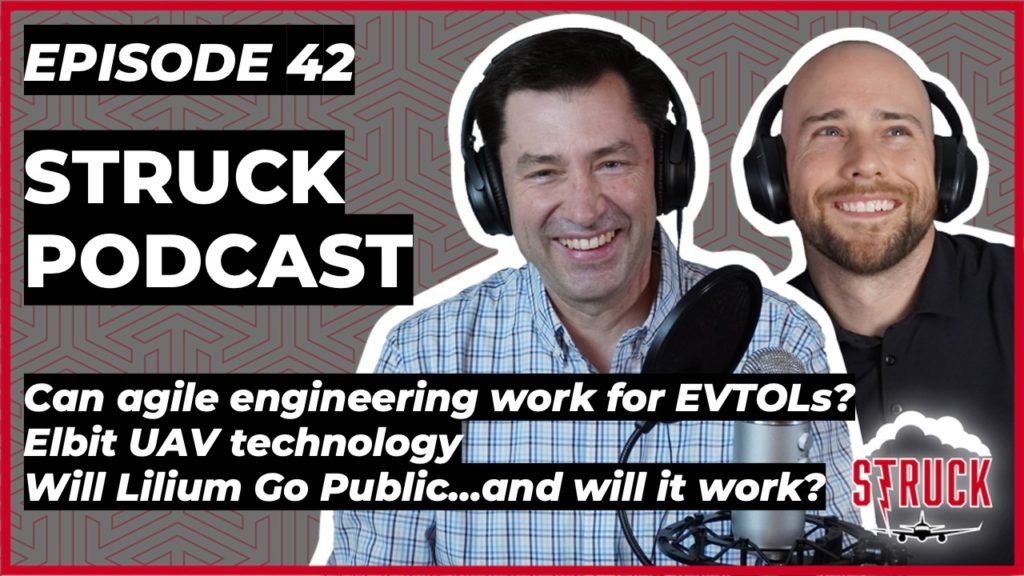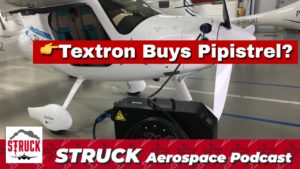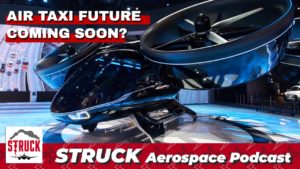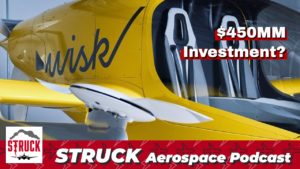Lilium’s CEO has publicly declared the desire to go public in the near future – but will it work? Can certification really be attained in just a few years? Elbit creates UAVs and their new models are garnering attention. And, a great article on agile engineering discussed its application to the EVTOL market and whether or not the approach can work. This and more on the Struck Aerospace Engineering Podcast EP42.
Learn more about Weather Guard StrikeTape segmented lightning diverter strips. Follow the show on YouTube, Twitter, Linkedin and visit us on the web. Have a question we can answer on the show? Email us!
Podcast: Play in new window | Download
EP42 – Lilium Going Public? Elbit UAVs & Can Agile Engineering Work for the EVTOL Infrastructure?
you’re listening to the struck podcast i’m Dan Blewett i’m Allen Hall and here on struck we talk about everything aviation aerospace engineering and lightning protection
welcome back to the struck podcast i’m your co-host Dan Blewett on today’s show uh number one we’re going to talk about oxford university has a interesting report out says they can make jet fuel from atmospheric co2 so really interesting development we’ll chat a little bit about a little bit about that the cessna citation is now 50 years old coming up this year in 2021 so we’ll talk about why that’s important with this monumental little plane we’ll talk about venus does lightning strike on venus these are good questions um in our engineering segment today we’ll talk about while agile engineering uh which is obviously a sort of a mainstay in silicon valley you know move fast develop your prototypes you know the those the saying move fast and break stuff does that really apply to maybe the evtol market and uh air travel in general probably not and then lastly in our evtol segment we’re going to talk about Elbit and a bunch about Lilium which a lot of really interesting news uh in the in the news cycle recently with them so al first let’s start with oxford university so they said they can use iron to turn carbon dioxide into jet fuel what’s your take on this well there’s been a number of different ways to make fuels from and you see some of this on television where they’ve used algae to make hydrocarbons or catalysts like in this oxford study it was a catalyst to create jet fuel so there’s a number of different ways to create hydrocarbons the question is what is it cost effective or not and at this point the catalyst method hasn’t been very cost effective or has used some rare earth metals like cobalt to do it this uses a obviously a lot cheaper materials to do it but there’s still it’s an energy-intensive process is it cheaper to do it this way or is it cheaper to refine petroleums to get to the jet fuel it’s going to take time on both sides i know there’s a big push in europe to make quote-unquote cleaner fuels this wouldn’t necessarily be cleaner but the carbon dioxide that goes into it is the carbon dioxide comes out of it so i guess it’s carbon dioxide neutral if that’s an advantage but what’s the cost right airlines spend so much money on fuel right now if you doubled or tripled that you would put airlines out of business a number of them would go out of business can’t afford it so there’s a lot of more work to do there it it is a good sign but i always when i see these i always always think all right this got to get some scale to it and see if you can drive down the cost just like tesla’s doing on like the gigafactory for the for the batteries they’re going to drive down the cost we’re going to produce them in massive scales this hasn’t been scaled up yet they’re still in the laboratory so you’re at least five to ten years away from having something real and then another couple of years away before the certification authorities would even let you use it uh so yeah so it’d be it would take a while and is that going to be chased out of the equation by electric power by hydrogen obviously we talked a bunch about hydrogen fuel cell technology you know this being five or 10 years away from any kind of viability is is it even worth chasing i don’t think so unless there is a huge cost savings like when they sat down and ran through what it would take to do this on an industrial scale could they make it less expensive than hydrogen i doubt it hydrogen will be really simple to make we all know how to make it using electricity just say break the bonds and then you got hydrogen out of water it’s it’s energy intensity but if you have extra energy to use the system to make it’s not very complicated and we all have a lot of history with hydrogen on the engineering side so hydrogen is probably the easier answer uh there’s a there’s a lot of hurdles and i think the one thing people don’t realize is that the certification authorities and the engine manufacturers dictate what fuel you can put in your aircraft right because there’s a lot of risk with a fuel that does that it damages the engine in some way like we’ve seen recently with some of the additives to stop algae growth that too much of that is bad too little that’s bad so all the little additives and uh things to make fuel burn properly in jet engines is super critical and is is approved with the engine design so you can’t vary that willy-nilly it takes a lot of a lot of engineering time interview time to do it and approve it which adds to the the profitability side of the equation which just makes it even harder to come up with a new new fuel system or a derivative fuel system in this case yeah so cessna is marking a uh really interesting 50th anniversary or anniversary of their cessna model 500 which essentially transformed their companies you know they went from just a general aviation manufacturer to more of a business aviation companies so i mean alan what sticks out to you as being prominent about this 50th anniversary well a lot of the cessna citation line hadn’t varied until until the 2000s late 90s 2000s citation 10 probably being that first real deviation from the citation 500 but that’s a very simple aircraft in today’s terms essentially straight wing simple fuselage simple layout pretty easy to fly uh it’s relatively simple to manufacture and that’s why cessna makes basically that same airplane at different derivatives today is that they can control the cost and it can be manufactured pretty easily the kicker i think on the 50th anniversary of this on the citation itself the baseline citation is there hasn’t been a lot of changes in the aircraft airframe design since then on the business side obviously we have the much larger aircraft with the gulf streams the threes fours fives and plus um the dassau and embraer have have been making airplanes but they’re basically the same airplane we haven’t seen a lot of changes so that real fundamental citation design in a long time uh we obviously things have gotten bigger engine performance has changed we sweep back the wings now but it’s not like we were talking about in the evital market whether it’s going to be significant change on the way aircraft fly and handle the basic citation 500 design is still in play today which it is interesting to consider since that first from 1903 to late to the 1970 there was a huge change in the way aircraft were built and designed and then when we get about 1970 it kind of stopped uh materials changed somewhat but there wasn’t huge changes in aircraft so i think the 50th anniversary comes with it’s little double-edged sword it’s great it’s been in in production and that baseline design has been around that long but the bad part about it is we haven’t really advanced aircraft design all that much so hopefully we will see some more advanced designs coming up in the next couple of years with the with the evtl market all right so in our engineering segment today we’re going to talk about a pretty interesting article by michael decourt um this article that he penned uh just last week and or this week in january uh he’s worked for lockheed martin uh the u.s state department the navy he’s been i.t for a long time with aircraft simulation stuff like that so his uh perspective in this article for urbanairmobilitynews.com was was pretty interesting so obviously with silicon valley a lot of these startup companies and obviously we’ve talked about the evtl market being heavy on startups who are trying to get their product to market you know if you listen to any of these stories like one of the podcasts i really enjoy is how i built this uh by npr and guy raz and it’s this common ideology of like hey we just need to get a prototype out there even if it’s not perfect even if it’s kind of like a beta you know our first product testers are almost like beta testing it for us in the open market uh you know mr de court here is arguing that that’s not gonna work with the evtol uh situation because obviously and alan you know this well if there’s one crash where one person’s killed one family you know dies um that’s gonna really set back the entire industry and of course there’s a lot of other implications there and he talks a lot about ground and air just the chaotic nature of communicating between those two types of transportation as we try to introduce you know aircraft into our you know city centers essentially what was your take on this article because it was really interesting it’s really well written i thought and brought up a lot of really good points um what’s your take on mr de court’s article well it first brought up the mvp process of silicon valley companies i don’t know if you’ve heard this term before then i have the minimal minimum viable product oh minimum viable product for right for sure just not the acronym right it’s so it’s uh it gets tossed around well we just need an mvp to get out the door and then software uh on an app on your iphone it doesn’t really make all that much difference right it may the app may not perform as well as you would have intended it to but it’s functional it’s that first generation get it out the door same thing happen with macintosh and most computers today that that first product is never like the the current generation on aircraft you can’t really do that you can’t have a aircraft that sort of flies you have to have an aircraft that has it has extremely high reliability that’s part of the certification of it yeah look only one out of 70 of these goes down that’s only like one and a half percent that’s great right yeah that’s 98.5 percent at 8 plus and in middle school that’s right yeah that doesn’t that doesn’t work right remember remember when the iphone had the problem with the antenna that you’d lose the the cell phone coverage if you if you held it if you held it you were holding it wrong right right steve jobs comes out and just says yeah all phones are like that in this case you can’t really have that right you can’t say well you know bob’s aircraft foul this guy so ark can fall out of the sky too it’s not like that at all and but that philosophy does permeate the engineering groups in silicon valley area it’s not very hard to to see that term used and thrown about a bit and if you watch newly developed components apps software whatever come out of silicon valley even tesla’s right that first those first teslas were not the most reliable things on the planet so it does become a design philosophy to just get something out the door and you really can’t do that in aircraft because you’re right the consequences have it an accident or an incident are so high on the on the valuation of the company you just can’t afford it so uh you really need to find people that have the right philosophy and the right design approach early in the aircraft design otherwise you catch problems much too late and it just costs you 10 100 times as much to fix this is why i always say one of the most most important groups in an aircraft design are the system safety people because they control how much and what goes into an aircraft to make it safe make it reliable they’re looking at reliability and if you don’t have that or you’re not thinking that way then the aircraft just is never going to get to one certified and two be reliable out in service so yeah there is there is a lot to say about the way you transition from one industry to another i i don’t think that really works all that well we saw that years ago with eclipse uh eclipse was sort of a silicon valley microsoft uh company in terms of the darling right yeah like yeah backed by everybody important right endorsed by michael was it michael or john travolta and wasn’t he one i think he was one of their endorsers i think it was travolta or is tom cruise one of the other i think they were both there one of the two either way super a-list yeah super a-list actors and and we had uh der hector del aguila on the show and he talked about you know that whole thing sort of uh running out of steam and running out of money and becoming a very chaotic uh environment so sure they thought they could design their own software system well they did that the computers that flew that aircraft they were going to design them are they going to design all the avionics at some point that was the intention yeah you can’t do that the issue is is it meet all the reliability numbers that’s the hard part and if in that case it didn’t so it’s it struggled it struggled for a lot of different reasons but that was one of many that it just felt like they were making computers and not airplanes it happens well and speaking of that in this article one of the interesting things he he suggests as the way forward is doing a lot of simulations um which kind of reminds me of like and you know any of these like sci-fi future futuristic movies like blade runner where you see these flying cars you know the movie the fifth element was a good example where we need to actually simulate you know these ev2 wells coming and going while there’s city buses and obviously they’re not talking about landing evtols on the sidewalk like that’s not what’s any in anyone’s mind but he’s saying look we need to have we need to simulate with computer modeling if we can these chaotic environments and have outages and have you know uh issues with communications and like we need to see what happens when things go wrong that seems to be what his big uh his big thesis is here that we have to be really ultra cautious about figuring out what’s going to happen before it happens because if we test that out in real world you know in my mind as i was reading this i was saying well yeah like what if in evtl is ready to land and they get the oh no you can’t land or something unexpected happens and right you’re between buildings and it could just be a catastrophe flying between buildings is a mistake to begin with and i think that there is a lot when you look at the e-vital uh imagery online you see a lot of evitals in places they are never going to be because you’re right any slight wind shift or change abrupt change to the aircraft performance this could send it hurdling into a building or into a crowd of people and that that is just never going to happen so it was an interesting article it does seem like there’s a lot that has to be explored and i think that segues pretty well into our final segment so we’ll talk about lillium last because i know you have a lot uh that you want to go through here but first let’s talk about elbit so their starliner uas is going to carry out environmental protection missions in canada potentially and this is a bigger this is a like a similar to like the pr the predator that the us yes the us air force has that same kind of design but al what sticks out at you about this albert and you know as an israeli company uh it seems like they’ve got some pretty good technology they have some great technology particularly in the uav drone market just because of where they are in the world they need to keep alert of on their borders all the time but that also lends itself to to shopping those designs elsewhere and there’s been a lot more uh drone usage for in one border patrol in the united states in canada and australia there’s a lot of of uh unmanned air vehicles out there the the the second part is the sort of monitoring the climate with uavs that has also been around for a number of years nasa did it about 10 maybe even 20 years ago now and they they did it i think it was with a predator an early version of the predator where they were monitoring thunderstorms and taking measurements around thunderstorms so it is a valuable relatively inexpensive way to monitor the climate because it doesn’t involve pilots and it’s a huge aircraft and the fuel burns a lot less so it’s just a much cheaper alternative to some of the larger aircraft that would typically be used for those kind of measurements it’s a good use of the technology i think we’re going to see more of it as the reliability of the aircraft gets goes up and it has gone up greatly in the last 10 years but also the payload capability and the amount of data they can push up and down that it lends itself to a variety of different tasks tests that may not have been envisioned when the aircraft were designed so you see the aircraft evolve into these select little marketplaces to fill these needs that would be much more expensive to do with a conventional aircraft so i think you’re going to see that continue and albert is just one of the players there but is a big player there because they have a lot of the technology so it’s energy kind of keep your fingers on the pulse of that because it changes so rapidly from year to year to year where they can use the uav technology
so moving on to lilium obviously this is uh such an interesting story evolving with them because they seem like they’re evolving into this darling very well-funded startup and we talked about joby recently and the fact that they’re also very well-funded uh they keep a lot of their secrets close to the vest they’ve also you know published a lot of patents recently because they’re on the move like they’re pushing hard towards eventual certification and lillium is doing the same thing uh but what was interesting so this story that you and i read on evtol.news which is a great website if you’re looking for evtol news aptly and aptly named but lilium got a lot of bad press i don’t know i don’t know if i would call it bad press but some engineers in the german magazine uh aero courier and uh der spiegel one of their big magazines they had a bunch of engineers five of them basically said that what lilium is claiming their evtol can do it can’t possibly do with the 36 ducted fans like the design you know the power of them it just doesn’t add up that they can carry this payload at this speed like they’re just sort of running the numbers with the data that’s been released and like this doesn’t look like it it’s going to make sense yet they still raised a ton of additional money after that publication released that so and then interesting news uh just in the last couple of days is that there can the ceo daniel uh wigan confirmed plans to take the company public so lots to unpack here right uh so where where do you want to start first well let’s just start with the financial part of it and what is happening there the going public is obviously is a way to raise money right that’s why you go public it’s just to raise cash to support what they are talking about uh building factories that’s essentially it it takes a lot of money to build a factory and get an airplane line up and running uh but it also has a sort of a political feel to it too where the german government seems to be involved on some level of trying to promote this aircraft which is fine i mean they can do that but there’s always that sort of theranos feel to it where a lot of things are being said but if whether you start talking physics and flight mechanics and ability to stay in the air for the length of time they’re talking about those numbers don’t calculate so what the marketplace does and what the engineers do tend to be two separate lanes and at least in the united states we have seen a number of of companies think they’re going to produce some great new technology advancement and can sell it to the marketplace but the engineers on the other side are going well there’s no way that’s going to happen and and so now we’re into that uh sort of dispute it’s not really a dispute because lilium isn’t making it a fight they’re just saying that the engineers who did that analysis haven’t don’t have all the information in front of them to make the analysis i don’t think that’s true i read through i actually translated the the article and read through it it’s not back of the envelope kind of numbers they’ve they’ve really done some digging into this and they have to make some estimations obviously because they don’t have the all the informations but what they if you read the article they’re giving lilium the benefit of the doubt there if there’s a chance to give lillium a benefit in the analysis they do and even with that benefit they’re saying the aircraft can only stay flying for about five minutes and that i think rings true to me that just the way that the system is set up and the amount of drag and whatever it’s going to have or it’s not going to keep the aircraft flying all that long because takeoff and landing eat up so much of the available energy in a storage battery because essentially all your thrust is that’s equal to lift or or the weight of the aircraft so uh you’re using a whole bunch of energy to stay aloft four flights should be less energy if you look at like the pipistral electric aircraft you’ll see those numbers so there’s just be a disconnect between the published numbers what they say they’re going to do and the engineering don’t align and in cases like that my take on it is to stop and address that issue and to show that it can do it but they’re lillian’s not doing that which i think is a little telling because they should be able to say here’s how we’re doing it and if it has to happen behind closed doors fine but when the when you don’t when you when the engineers are saying the aircraft can stay on law for five minutes and you can say you’re saying it can stale off for an hour those are there’s a widely different results that’s a that’s a big gap it’s a big gap right we’re not talking about between 30 minutes and 40 minutes we’re talking about 5 and 60. i don’t i i don’t think lillian’s going to play this quite right and it makes you wonder when they go public is it a way to sort of divert attention and that’s the way theranose was playing it is that they’d make announcements they’d make publication and all the journalists at the time and not saying not necessarily equating the two but the sort of the flow tends to be similar is that the journalistic community doesn’t way to evaluate any of this they don’t have the skill set they just don’t and why they don’t call up the engineers and say is this real especially in germany call up one of the old retired airbus engineers and say hey does this make any sense at all is it in the ballpark they haven’t done that what they’ve done what the journalists have done is said well we have five engineers that dispute it and we have lilium that says well they don’t have all the information well somebody’s right right uh and so the the way this is playing out is weird yeah and it does sound sort of reminiscent of the theranos uh situation because she kept elizabeth holm the ceo she kept saying or she just kept like moving on people like we want to see it work let’s see the machine let’s see the machine let’s and she just like kept kept everyone moving saying oh you got to get on the train like so you know people were on a in a fury to that’s not the right word but there was like this froth built up where everyone’s like i i just don’t want to miss the train like here’s my money here’s my money like all invested i’ll invest you know i haven’t seen it like i i just i just don’t want to to miss this boat and that was what walgreens said at the end where they’re like we just we just really didn’t think it through and just kept we just didn’t want to miss out on this opportunity and have some other big company beat us do it right and so everyone kept throwing money but she never like no one ever saw the machine work that was the crazy thing and people started to be like why can’t we see it work let us see it work just show it to us they’re in the other room bring them in and just never happen never happened or they fake it or they would fake it right they would fake it and part of the part of that sort of process that happens is from what i have seen on similar situations is they put people on the board who are very powerful and they have lawyers who can basically silence all criticism which is what their nose did right they went out and they silenced all criticism by sending in threatening letters made the employees sign these non-disclosures uh threatening to sue former employees who talked about anything they did it or saw at their nose so it kept this cocoon i’m feeling that cocoon going on i feel that cocoon going on in a couple of these evtal companies right now where no one’s talking about what actually is happening like like some of the flight test stuff if they’re flight tests and aircraft there must be people around there see that flight tests go on and must know right there must be more than 20 people at any these sites that are flying these aircraft and know that yeah and you know the one of the weird things that happened this week i don’t know if you caught it dan was there was a a news story about the kitty hawk heavyside aircraft and i thought that was fascinating because they had uh they were showing some of the fuselage shells or the aircraft shells the carbon fiber shells there and they were talking to the um ceo of i guess it’s whisk i guess for the heavy side uh and what he was saying was the flight duration time and if don’t hold me to this but i it sounded about right was like or the flight distance time was maybe a hundred miles one person so it’s a smaller aircraft one person i think it would say to go to 100 miles how do we do that we put four or five people in like when you start multiplying the number of bodies inside these aircraft although the weight goes up and then what do you what do you have can you do 100 miles when you got four four former people in the in the aircraft i don’t think so right that the math doesn’t work right so when when when i saw the heavy side little snippets uh i thought well that’s you know there’s a bass line and piper strolls it says the same thing by the way pimple stroll if you look at their data sheet their data sheet makes sense you can actually run the numbers that go yeah okay all this makes sense i we don’t see those sort of things out of a couple of these larger evito companies right now and starts get worrisome yeah and they might just be buying time and of course yeah you see this with some of these consumer electronics like we’ve talked about uh you know for example like i own an electric scooter we’ve talked about it a little little bits and pieces but if you read some of the specs on like these electric scooters they’ll say you know can reach a top speed of 17 miles per hour and go 12 miles on a charge asterisk and the asterisk is like well if you’re if you’re 135 pounds if you’re you as a one human are 135 pounds so it’s like okay well i weigh 200 pounds so how far does that get me well i only get i only get 15.2 miles per hour top speed and seven miles of range because i you know i’m not their prototypical human so when they say two people does it mean two average americans where average americans weigh 375 pounds or does it mean you know average uh you know french person where they slim and you know svelte so right yeah it’s uh they tend to massage those numbers with some of those consumer things but ultimately you know as we talked about with aircraft they’re gonna have to say when it’s ready to go like this is our capacity this is like these are the real numbers because they’re not going to load people in there and put luggage in there and have the thing go down obviously like they’re going to be very forthcoming at some point right they have to and as as soon as they don’t meet numbers then on a publicly traded company the value will collapse if it if they’re not anywhere close to those published numbers it’ll collapse relatively quickly what has been bounced around in the back of my head the last couple of months on the evtl market is the addition of a secondary power source if it’s not battery can the if battery won’t get them where they want to go do they add a little turbine engine generator system that burns jet a or 100 low lead fuel or does it burn hydrogen or something to basically put a lot more energy storage onto the aircraft and get it to fly further that that makes it really starting to feel that way because everybody’s in hiding in terms of what the technology is and if it it’s still electric but there may be this hydrogen element to it or there may be this temporary jet a element to it until the battery capacities can get increased those are all possibilities now and i don’t think it defeats the purpose of the aircraft i don’t think it does that at all but it does change because it doesn’t have to be yeah it doesn’t have to be electric it’s not like you know this is gonna if it’s not all electric it’s gonna destroy the planet it’s just gonna be another small you know contributor to greenhouse gases and all that like no one said these have to be electric they’re just doing it because that technology is getting pretty close right right right and and all aircraft go through that initial stage every like we were talking about the citation 500 when that was initially designed and certified way back in 1971 it’s this steam engine yeah essentially yeah in terms of the jet technology they had now then compared to now yeah i mean that’s completely different in terms of efficiency wise why can’t the e veto market go through that same transition i don’t know but i one of the things that’s starting to worry me a little bit is how fast uh takeoff needs to be how little time they want to spend and hover because it eats so much power and what that means in terms of the controllability pilot piloting aspect because you want to go from essentially to keep the the burn down on the energy usage you want to go from zero to cruise flight as fast as you can and the way that some of these aircraft were designed uh joe b whisk a number of them is that the wings don’t provide a lot of lift they they provide lift at cruise speed and if that’s the case then your takeoffs and landing will be very exciting they will be very very exciting well and the last thing i want to bring up is you know one common i guess it’s an old adage is they say don’t attribute to malice what you could just attribute to incompetence right or stupidity right so with some of these companies like obviously theranos that was a legitimate scandal like they defrauded investors and everybody she didn’t have the capability to make any of those decisions at all she knew nothing about the technology she was just like the the front person essentially she didn’t have a background in any of that technology yeah um but with all these companies just because they seem like they’re keeping information close to the vest maybe they don’t have it all sorted out yet they they might know like yeah like we’re just not right there so we just got to keep this close even though we’re getting criticized there might not be any sort of like yeah not might be any like anything perfidious going on but just the fact that we feel like we can solve this solution we know we’re not right there yet people have kind of figured it out in the public that maybe we can’t meet some of these claims so we’re just going to like keep it to the close to the vest until we can because we really believe that we can do it so it could just be something like that going on i mean with all these they can’t all just be no you know you just give them the benefit of the doubt which i know you are and uh it’s just a situation where who knows what their what their internal process is trying to get this all these solutions which are all very different just finalized and to do what they hopefully say they can do but as you said many of them probably can’t do what they’re claiming to do right now and so they might just be in this situation where they’re just like oh man we’ve made a lot of promises to a lot of people and this isn’t working how do we save face when we have all this amount of money that’s got to be a really scary hole to dig yourself into as a as a company founder where you’re like i’ve told a lot of people this is going to work and it’s not going to work uh what do we do now yeah that’s got to be a terrifying situation it is i’ve been around a number of aircraft companies that been through that process on conventional aircraft and the discussion kind of goes like this we put out published numbers and this what are we going to do we’re not going to make those numbers aircraft’s too heavy it burns too much fuel what do we do and but those numbers are not off by a factor of five right they’re off by five five percent right and then that’s a big deal and that that’s that’s sort of uh conference room staple throwing time but in these cases we’re not we we could be really far off unless there’s some other technology advancement that could explain how they’re going to accomplish these things because we haven’t seen it and all it takes is i was having a discussion about this over the weekend all it would take to get rid of all of this is a test flight that that’s true we have the ability to shoot a 60-minute video great fly the aircraft around in circles like the wright brothers did back in 1908 or whatever it was just fly it around the field for 60 minutes and land it that’s all we ask let’s see if this is really true and that solves it all but we don’t have that yet and it starts to worry me that we don’t have that why not we should have that if you’re really down going to be able to produce this aircraft and deliver somewhat close to what is really promised then all it takes is a youtube video that’s all it takes yeah yep that’s true yeah and it’s uh it’s just an interesting situation where like you said if it falls so far short they’re you know because with a lot of these evtols they might need to their business model in the future might be getting someone from long island onto a rooftop in manhattan right and so they’ve got they’ve got to make that whatever it is 42 mile journey it said to to fit the business model and if they can’t do that so now they’re only you know they fall very short of the numbers they can only make it 26 miles on a charge it’s like this whole thing collapses so that’s support for you know a that sort of theory of chaos but also your point of maybe we just need to put another secondary power source in this so we can always make that flight and then when battery technology improves then we’re good to go but right that’s the big scary thing is if they can’t do they can’t make that leg and fulfill their essentially that mission of short distance flights then they’ve got nothing i kind of wonder if the short distance flights are going to be of enough value to keep an aircraft company going uber elevate closed because i i think there’s a reason why uber elevate closed obviously kova didn’t help their overall business and the automotive business isn’t doing super well at this point but at some point somebody in the back rooms at uber elevate had to sit down with a calculator and go this is possible this isn’t possible what are we doing and if we’re gonna if we uber are going to invest in this then it’s time to pony up and show us you can do this or we’re not going to be around anymore i have that sneaky feeling that that was part of the whole closing of uber uber elevate was a lot of these companies are promising a lot uh but well we’re really far away right you saw that with john recently what john has hooked up with the company to do what i’m just talking about basically provide a secondary power source to their aircraft to extend the range to where they can be a value proposition for sort of those medium length flights those hundred mile flights the reason jot’s doing that is because batteries won’t get them there today but they may in the future and overall the whole whole system is a lot more efficient than aircraft we use today and it costs a lot less to operate what’s the problem with putting an additional power source besides the added weight but what’s the distance of putting a smaller additional power source that burns some sort of hydrogen to extend the range i don’t see that stopping the marketplace but boy oh boy it sure is quiet right now all right well that’ll do it for today’s episode of struck if you’re new to the show thank you so much for listening and please leave review and subscribe on itunes spotify or wherever you listen to podcasts check out the weather guard lightning tech youtube channel for video episodes full interviews and short clips from the show and follow us on linkedin twitter instagram and facebook our handle is at wg lightning tune in next tuesday for another great episode on aviation aerospace engineering and lightning protection












